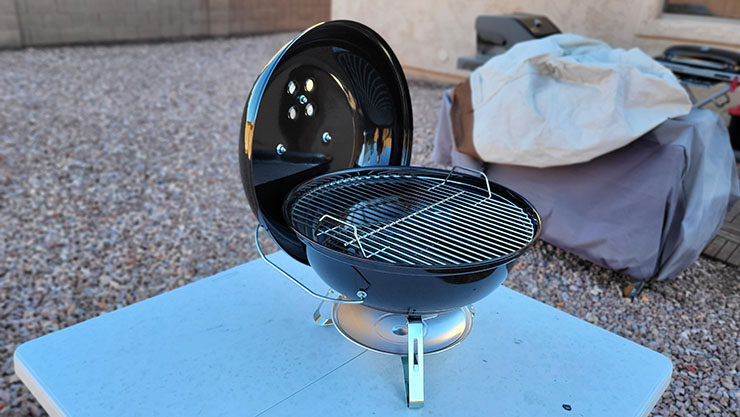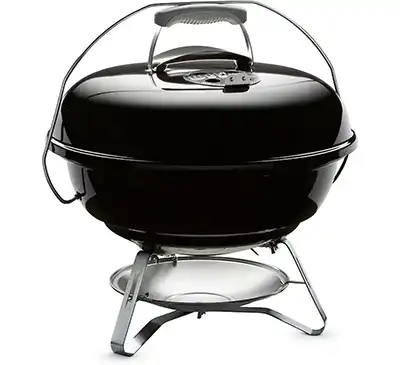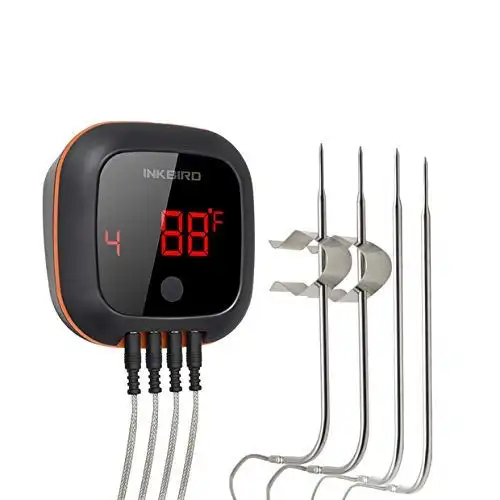Weber Jumbo Joe Review: Compact Charcoal Grill to Use on the Go

The Weber Jumbo Joe takes the design of the classic Weber Kettle Charcoal Grill, and shrinks it down for portability.
I’ve been putting the Jumbo Joe through its paces over the last 6 weeks to learn what this mini kettle grill can do. In this review, I’ll run through everything I liked about the Jumbo Joe, go over a few of the drawbacks.
- Small, lightweight and easy to transport
- Good temperature control due to adjustable dampers
- Well built with durable materials
- No dome temperature probe
Weber Jumbo Joe overview & first impressions
At 18 inches wide, the Jumbo Joe is a slightly larger version of the Weber Smokey Joe (which is 14 inches wide).
The two are very similar when it comes to features and shape. The key difference is the Jumbo Joe has a Tuck-N-Carry™ lid lock system that allows you to lock down the lid while transporting the grill from place to place.
I decided to go with the Jumbo Joe because the extra space comes in super handy, and it’s still small enough to transport.
While barbecue mainstays like brisket, pork butts, and spare ribs will be difficult to impossible to cook on this grill; steaks, burgers, sausages, and even a whole chicken are doable.
Weber Jumbo Joe Specifications
| Fuel | Charcoal (Lump or Briquette) |
| Weight | 18 lbs. |
| Product Dimensions | 19.7″H x 19.7″W x 20.5″D |
| Total Cooking Area | 240 square inches |
| Warranty | 10-year rust 5-year plastic 2-year parts |
| BTUs | N/A |
| Price | Check Latest Price |
When it comes to features, the Jumbo Joe keeps things fairly basic. A fact that is reflected in the low price point.
If you are familiar with the larger Weber Kettle-style grill you’ll recognize the adjustable vents on the bottom and top to control airflow.
Key features:
- Tuck-N-Carry™ lid lock: Doubles as a lid holder to avoid placing the lid on the ground). Can also block wind from putting your flame out while trying to light the coals.
- Top and bottom dampers: Controls air flow which helps regulate temperature.
- Plated steel cooking grate: Easy to clean and retains heat well.
- Aluminum plate: Helps catch ash and charcoal pieces that fall through the bottom damper.
- Plastic lid handle: Doesn’t get too hot so you can move your grill mid cook if needed.
As I mentioned before, the handle doubles as a lock to hold the lid into place during travel. It can also be used to hold the lid upright, which can be handy for blocking wind.

Inside the grill are two grates. The first is used to hold your charcoal briquettes, and the second is for your food. Below the grill is a plate that catches any ash or pieces of charcoal that happen to fall below the bottom air vent.
I was worried the small size of the grill would be too small to allow for indirect cooking. But overall, I was pleased with the cooking experience in spite of its smaller size.
What we like:
- Portability – Small and lightweight, the grill is really easy to transport from place to place.
- Temperature control – The adjustable dampers allow for adequate temperature control. Since it is a charcoal grill you can’t expect more than that.
- Well built – The materials used are durable and constructed to the standard that is expected from
Weber . Just because it is a lower cost grill, doesn’t mean it shows in the area of build quality.
What we don’t like:
- Ash catching tray – The tray is tricky to remove and put back in and causes ash to blow everywhere in the wind. I would have preferrred an enclosed system like you get on the premium Kettle.
- No dome temperature probe – You’ll have to use your own probe to read the ambient temperature of the grill. Or, you could guess I suppose.
Those two negatives aren’t enough to put us off. The Jumbo Joe hits the sweet spot in terms of size and portability and for under $100 it’s easily our favorite portable charcoal grill.
Unboxing and setting up the Jumbo Joe
Here are some things I noticed after opening the box and removing all of the contents:
- Every item was packaged and protected well inside the main vessel of the grill.
- Those items included the two pieces that make up the dome, 2 steel racks, Tuck and Carry Lid Lock, aluminum grease pan, and 2 pieces for the legs/stand.
- No tools were included to assist with the set-up process. I used a flat and phillips head screwdriver.

Setup literally took as long as a commercial break during a Sunday football game, because that’s what I was doing when I put this thing together. It was a really intuitive assembly so I didn’t need the instructions.
You have to love Weber build quality
I was worried that at such a low price point
Overall, The Jumbo Joe is solidly constructed and can withstand any accidental drops or dings that may occur during transport.

The porcelain-enameled lid and bowl allow for heat retention which reduces the temperature swings that can be expected from charcoal grilling.
The steel grates are well built and easy to clean off any debri stuck to them.
How easy is the Weber Jumbo Joe to use?
I chose lump charcoal over briquettes for my first use.
In retrospect, using lump charcoal may have been a mistake. I bought 2 bags of lump charcoal and both contained massive chunks that were too big for this grill.
Getting the charcoal lit was a painless experience with Weber’s Rapidfire Chimney Starter.

It might seem like overkill when you see how big the chimney starter is compared to the actual grill, but I didn’t have to mess with any lighter fluid or oils in order to light the coals and get them to the proper burn point.
You’ll need to BYO thermometer to check temperatures
The Smokey Joe is primarily designed for direct searing so it makes sense
However, it’s large enough to cook a whole chicken, and i like to know what temperature I’m cooking at so I used an Inkbird Bluetooth Digital Thermometer to measure temperatures.
It comes with a probe specifically designed to measure ambient temperatures in addition to 3 meat probes. This is a nice feature, especially when you’re cooking with old school grills like these that don’t include any built in thermometers.
Learning how to control temperatures was pretty simple. If you want to get your grill up to temperature, open both vents after adding the lit coals. For steaks, I just keep both vents open all the way so I can get the coals as hot as possible.
Once you have reached the temp you like, close the top vent ¾’s of the way. This is a good setting for roasting something like a chicken or pork loin at a consistent 350°F temperature without burning out the coals too quickly. Air will enter through the bottom vent, feed the flames and minimal heat will escape out the top.

If you want to decrease the temperature, close the bottom vent and open the top. To extinguish the coals altogether, close both vents and let your grill sit for at least 20 minutes. To be extra safe, I would lock the lid with the Tuck-N-Carry™ lid lock. The lack of air in the grill will cause the charcoal to eventually flame out.
The Jumbo Joe is still easy to transport
This is a grill you can take almost anywhere and enjoy a nice meal. It makes a great option for the beach or at a tailgate and you can fit it inside any vehicle, no matter the size.
If you’re going to take it camping however, definitely opt for briquettes over lump charcoal. The embers from the startup process are just too much of a fire risk in the forest or desert.
Cooking on the Jumbo Joe
The Jumbo Joe is very capable if you want to roast something like a whole chicken or bottom round. You can also smoke small meats low and slow like sausage, pork tenderloins, and even a full rack of baby back ribs.

Where this grill shines is searing a nice-sized steak. I thoroughly enjoyed cooking my 3/4 inch thick sirloins on the grill. After getting the grill to 600°F, a few minutes on each side is all it took to get to medium-rare.
I also cooked burgers, pork chops, chicken thighs, and baby back ribs. The chicken skin turned out well-charred and crispy.
I can see how handy this grill would be as a secondary grill to use for searing. For example if you are reverse searing steak you could do the first part on a larger grill before finishing with a quick sear on the Jumbo Joe.
Cleaning the grill
Due to the small amount of parts, cleaning the entire grill involved a short, 1 hour soak in grill cleaner and a spray from the hose. Cleaning the grates themselves took little effort to scrub the debri off.
Testing the product
Using an external digital thermometer, I found the Jumbo Joe was able to hold a consistent temperature of 350°F pretty well for a small sized grill. The only temperature reduction was due to the coals themselves, not heat loss from poor insulation or venting.
Alternatives to consider
If you want something a little more compact and still need to cook with charcoal, then check out the Weber Go Anywhere Charcoal Grill.

Its small, toolbox-like size is great for day trips or taking the boat out on the lake.
I have also tested and reviewed the Weber Traveler.
While it’s not exactly an apples-to-apples comparison since the Traveler is a gas-fueled grill, if you want a larger sized-grill that offers portability and convenience it’s definitely one to consider.
With a unique, foldable design the
Should you buy Weber Jumbo Joe?
I’ll be honest, for portability, I prefer a gas grill. But since charcoal wins in the flavor department, the extra effort ensures you can enjoy a well charred steak or hamburger, no matter where you are. And for portable charcoal grills, you can’t do much better than the
- Small, lightweight and easy to transport
- Good temperature control due to adjustable dampers
- Well built with durable materials
- No dome temperature probe











